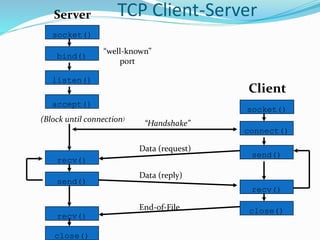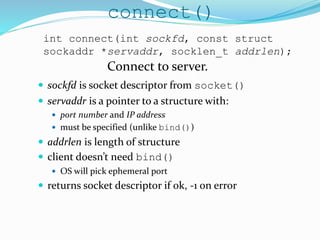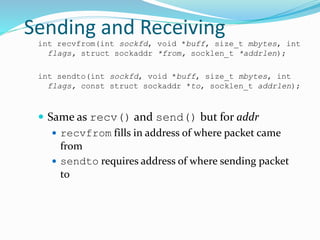Basics of sockets
- 2. Socket basics Socket basics Socket details (TCP and UDP) Socket options
- 3. Socket Basics (1 of 2) An end-point for an Internet network connection what the application layer “plugs into” User Application Socket Operating System Transport Layer Internet Protocol Layer User sees “descriptor” - integer index or object handle like: FILE *, or file index from open() returned by socket() call (more later) programmer cares about Application Programming Interface (API)
- 4. Socket Basics (2 of 2) End point determined by two things: Host address: IP address is Network Layer Port number: is Transport Layer Two end-points determine a connection: socket pair ex: 206.62.226.35,p21 + 198.69.10.2,p1500 ex: 206.62.226.35,p21 + 198.69.10.2,p1499
- 5. Ports Numbers (typical, since vary by OS): 0-1023 “reserved”, must be root 1024 - 5000 “ephemeral” Above 5000 for general use (50,000 is specified max) Well-known, reserved services (see /etc/services in Unix): ftp 21/tcp telnet 23/tcp finger 79/tcp snmp 161/udp
- 6. Transport Layer UDP: User Datagram Protocol no acknowledgements no retransmissions out of order, duplicates possible connectionless TCP: Transmission Control Protocol reliable (in order, all arrive, no duplicates) flow control Connection-based While TCP ~95% of all flows and packets, much UDP traffic is games!
- 7. Socket Details Outline Structure to hold address information Functions pass address from user to OS bind() connect() sendto() Functions pass address from OS to user accept() recvfrom()
- 10. Socket Address Structure struct in_addr { in_addr_t s_addr; /* 32-bit IPv4 addresses */ }; struct sockaddr_in { unit8_t sin_len; /* length of structure */ sa_family_t sin_family; /* AF_INET */ in_port_t sin_port; /* TCP/UDP Port num */ struct in_addr sin_addr; /* IPv4 address (above) */ char sin_zero[8]; /* unused */ } Are also “generic” and “IPv6” socket structures
- 11. Byte Ordering
- 13. TCP Client-Server socket() bind() listen() accept() Server socket() connect() send() recv() Client (Block until connection) “Handshake” recv() send() Data (request) Data (reply) close()End-of-File recv() close() “well-known” port
- 14. socket() int socket(int family, int type, int protocol); Create a socket, giving access to transport layer service. family is one of AF_INET (IPv4), AF_INET6 (IPv6), AF_LOCAL (local Unix), AF_ROUTE (access to routing tables), AF_KEY (new, for encryption) type is one of SOCK_STREAM (TCP), SOCK_DGRAM (UDP) SOCK_RAW (for special IP packets, PING, etc. Must be root) setuid bit (-rws--x--x root 1997 /sbin/ping*) protocol is 0 (used for some raw socket options) upon success returns socket descriptor Integer, like file descriptor Return -1 if failure
- 15. bind() sockfd is socket descriptor from socket() myaddr is a pointer to address struct with: port number and IP address if port is 0, then host will pick ephemeral port not usually for server (exception RPC port-map) IP address != INADDR_ANY (unless multiple nics) addrlen is length of structure returns 0 if ok, -1 on error EADDRINUSE (“Address already in use”) int bind(int sockfd, const struct sockaddr *myaddr, socklen_t addrlen); Assign a local protocol address (“name”) to a socket.
- 16. listen() sockfd is socket descriptor from socket() backlog is maximum number of incomplete connections historically 5 rarely above 15 on a even moderate Web server! Sockets default to active (for a client) change to passive so OS will accept connection int listen(int sockfd, int backlog); Change socket state for TCP server.
- 17. accept() sockfd is socket descriptor from socket() cliaddr and addrlen return protocol address from client returns brand new descriptor, created by OS note, if create new process or thread, can create concurrent server int accept(int sockfd, struct sockaddr cliaddr, socklen_t *addrlen); Return next completed connection.
- 18. close() sockfd is socket descriptor from socket() closes socket for reading/writing returns (doesn’t block) attempts to send any unsent data socket option SO_LINGER block until data sent or discard any remaining data returns -1 if error int close(int sockfd); Close socket for use.
- 19. TCP Client-Serversocket() bind() listen() accept() Server socket() connect() send() recv() Client (Block until connection) “Handshake” recv() send() Data (request) Data (reply) close()End-of-File recv() close() “well-known” port
- 20. connect() sockfd is socket descriptor from socket() servaddr is a pointer to a structure with: port number and IP address must be specified (unlike bind()) addrlen is length of structure client doesn’t need bind() OS will pick ephemeral port returns socket descriptor if ok, -1 on error int connect(int sockfd, const struct sockaddr *servaddr, socklen_t addrlen); Connect to server.
- 21. Sending and Receiving int recv(int sockfd, void *buff, size_t mbytes, int flags); int send(int sockfd, void *buff, size_t mbytes, int flags);
- 22. UDP Client-Server socket() bind() recvfrom() Server socket() sendto() recvfrom() Client (Block until receive datagram) sendto() Data (request) Data (reply) close() “well-known” port - No “handshake” - No simultaneous close - No fork()/spawn() for concurrent servers!
- 23. Sending and Receiving int recvfrom(int sockfd, void *buff, size_t mbytes, int flags, struct sockaddr *from, socklen_t *addrlen); int sendto(int sockfd, void *buff, size_t mbytes, int flags, const struct sockaddr *to, socklen_t addrlen); Same as recv() and send() but for addr recvfrom fills in address of where packet came from sendto requires address of where sending packet to
- 24. connect() with UDP Record address and port of peer datagrams to/from others are not allowed does not do three way handshake, or connection “connect” a misnomer, here. Should be setpeername() Use send() instead of sendto() Use recv() instead of recvfrom() Can change connect or unconnect by repeating connect() call (Can do similar with bind() on receiver)
- 25. Why use connected UDP? • Send two datagrams unconnected: – connect the socket – output first dgram – unconnect the socket – connect the socket – ouput second dgram – unconnect the socket • Send two datagrams connected: – connect the socket – output first dgram – ouput second dgram
- 26. Socket Options setsockopt(), getsockopt() SO_LINGER upon close, discard data or block until sent SO_RCVBUF, SO_SNDBUF change buffer sizes for TCP is “pipeline”, for UDP is “discard” SO_RCVLOWAT, SO_SNDLOWAT how much data before “readable” via select() SO_RCVTIMEO, SO_SNDTIMEO timeouts
- 27. fcntl() ‘File control’ but used for sockets, too Signal driven sockets Set socket owner Get socket owner Set socket non-blocking flags = fcntl(sockfd, F_GETFL, 0); flags |= O_NONBLOCK; fcntl(sockfd, F_SETFL, flags); Beware not getting flags before setting!
- 28. Concurrent Servers Close sock in child, newsock in parent Reference count for socket descriptor Text segment sock = socket() /* setup socket */ while (1) { newsock = accept(sock) fork() if child read(newsock) until exit } Parent int sock; int newsock; Child int sock; int newsock;










![Socket Address Structure
struct in_addr {
in_addr_t s_addr; /* 32-bit IPv4
addresses */
};
struct sockaddr_in {
unit8_t sin_len; /* length of structure
*/
sa_family_t sin_family; /* AF_INET */
in_port_t sin_port; /* TCP/UDP Port
num */
struct in_addr sin_addr; /* IPv4 address
(above) */
char sin_zero[8]; /* unused */
}
Are also “generic” and “IPv6” socket structures](https://image.slidesharecdn.com/basicsofsockets-161002135820/85/Basics-of-sockets-10-320.jpg)

















